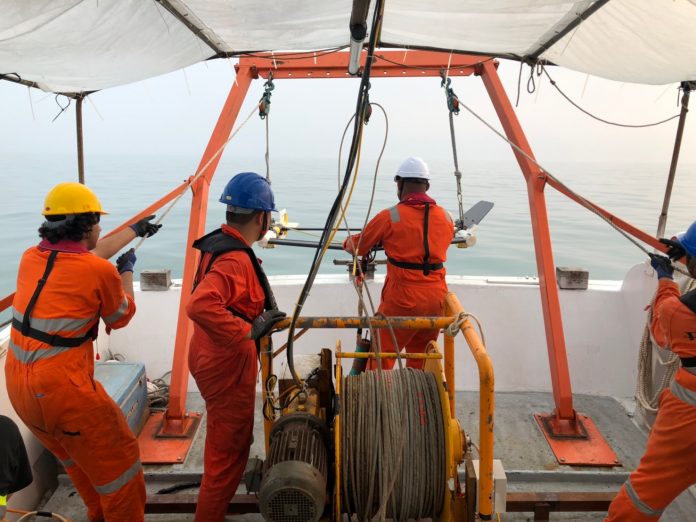Dr Gwoshyh Song of Global Aqua Survey Ltd discusses the challenges of clearing unexploded ordnance ahead of offshore wind farm developments
During the Second World War, the island of Taiwan was a Japanese military stronghold in the Western Pacific. The Imperial Japanese Navy operated heavily out of Taiwan. Many of the Japanese forces participating in the Aerial Battle of Taiwan-Okinawa were based in Taiwan. Important Japanese military bases and industrial centres throughout Taiwan were targets of heavy American bombing. Several areas were heavily mined by the end of the war. For example during recent dredging operations (2016) a number of naval mines were accidentally encountered offshore Kaohsiung, Southern Taiwan. Therefore, requirement is assumed that the smallest relevant UXO item to be inspected. For instant, there is a 250lbs bomb with a ferromagnetic content of approximately 50kg in the Guanyin area; in Changhua area, the smallest UXO for detection is an US 500lb MC Bomb to 2.0m below existing seabed level.
This US 500lb MC bomb, which is cylindrical and made of steel is measured 1.20m in length with a diameter of 0.36m, referred from the Ordtek consultant company. This item has a Net Explosive Quantity of approximately 126kg of TNT. Therefore, before any construction taken place in wind farm area, such as drilling operation as well as cable laying work, quality parameters for the acquisition of the geophysical data sets for UXO detection and to achieve an ALARP sign-off shall be performed by conducting following surveys:
o Magnetometer (MAG)
o Multibeam Echo-sounder (MBES)
o Side Scan Sonar (SSS)
However, when conducting the multibeam and side-scan survey, the small target measured 1.20m in length with a diameter of 0.36m has been quite hard to be detected. The major data for detection shall be magnetic anomaly. If a ferromagnetic object (in casus UXO) is present on the bottom, or is buried in the sediment, the Earth’s magnetic field is locally influenced by the magnetic field of the object.
The amplitude and horizontal extension of the anomaly, and thus the detection limit depends upon: 1) The mass and the shape of the object; 2) The magnetic properties of the object; 3) Distance between magnetometer sensor and object. If detection limit of around 2-3nT for ferrous objects using a magnetometer is implied. 250 lbs bombs with a sensor to object distance of up to 6-8m. When corresponds to maximal burial depths of 2-4m, flight altitude of the magnetometer sensor shall be 4m for 250 lbs aerial bombs, or 6m flight altitude for 500 lbs aerial bombs.
As a result, there are two special requirements in conducting UXO survey. Firstly, an accurate 3D positioning method shall be implanted; since survey tracks spacing at several meters shall aligned parallel in line, and altitude of the magnetic sensors above seabed shall be recorded. Wide Area Differential GPS (WADG) plus UltraShort Base Line (USBL) underwater positioning is required.
Secondly, Magnetometer array is necessary. In general, the typical equipment is to align two magnetometers spacing at 1.5 meter in a so called TVG. The magnetometer array uses the altimeters and depth sensor, which allows an active flight control of the sensors (such as Geometrics G882) with a limited flight altitude of less than 4m above seabed. Reason needed to use an array is to calculate the exact location of UXO object with the intersection by two distances method, such that we can estimate burial depth of the object if the distances to seabed level of the senor are measured.
Accuracy test needed to be conducted in SIT trial which shall be done immediately after mobilisation to ensure the availability of the Surrogate Item Trial (SIT) for reference values to base calculations for estimated burial depth and mass of the objects. The trial is done using iron made objects with different weights at least 50kg dropping on seabed at known positions. It shall include several passes made at various offsets to the target and in various vessel orientations to confirm the sensitivity of the gradiometer system
Global Aqua Survey Ltd in corporate with Neptune Marine Service has been conducting UXO surveys since 2018. The Clients are the WPD for Guanyin offshore wind farm (OWF), and the Macquarie for Formosa II OWF. In the Guanyin OWF, there were 52 survey sites, each with 200m by 200m square area, to be surveyed. Survey lanes spacing at 6.5m needed at least 40 survey lines to achieve total coverage of data. For the completion of this UXO survey, survey period was from March 2019 to Late August 2019 with total survey time over 5 months.








